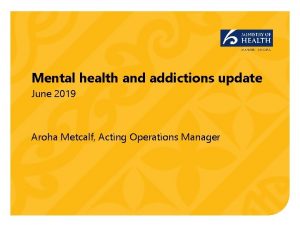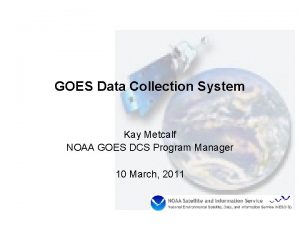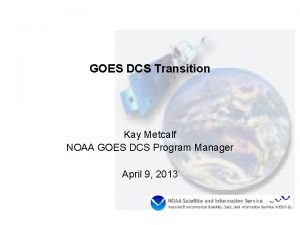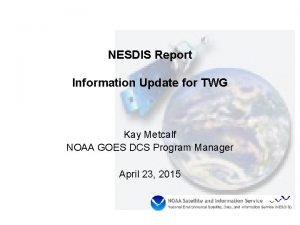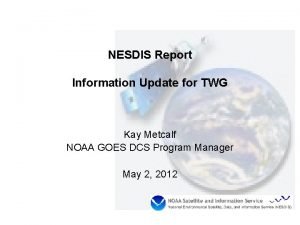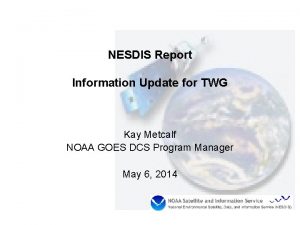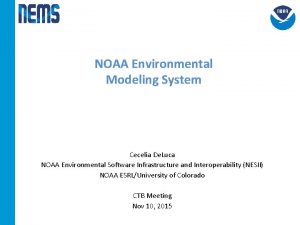GOES Data Collection System Kay Metcalf NOAA GOES








- Slides: 8

GOES Data Collection System Kay Metcalf NOAA GOES DCS Program Manager NOAA/NESDIS Office of Satellite and Products Operations Presented to SATCOM September, 2016

What is GOES DCS? • A GOES data relay service used for the collection and distribution in real-time of environmental data from remote data collection platforms located throughout the Western Hemisphere • Started in 1974 as an experimental system for collecting real-time data that has evolved into a National Critical operational system used by many Federal, State and Local agencies • Has evolved into the backbone of real-time data collection programs for many environmental agencies • Many Emergency warning systems in the U. S. and neighboring countries rely on data delivered through GOES DCS • Restricted by federal regulation to environmental, government or government sponsored users. Feb-21 NOAA GOES DCS 2

Numbers, please? • More than 28, 000 transmitters are sending data through GOES • Most transmit every hour, but some are transmitting every half hour, some every 15 minutes. EVERYONE is pushing for more. • Tide Gages monitoring for tsunamis report every 5 or 6 minutes. • 800, 000 messages per day. • Estimated 8, 000 (million) observations per day into the global observing system. • 800 user agencies • 1200 individual users registered for system access. Feb-21 NOAA GOES DCS 3

GOES DCS System Diagram Feb-21 NOAA GOES DCS 4

GOES DCS Users • National Weather Service – largest single data user • • • National Ocean Service(CO-OPS, PORTS) National Climatic Data Center (CRN) National Data Buoy Center Pacific Tsunami Warning Center US Army Corps of Engineers US Air Force US Navy National Interagency Fire Center National Forest Service Bureau of Land Management US Geological Survey – largest single platform operator Feb-21 • • • Bureau of Reclamation National Park Service Department of State (International Boundary & Water Commission) Multiple State Agencies Canadian Environmental Agencies South and Central American Environmental Agencies Caribbean Tsunami Network Pacific Island Nations Caribbean Island National • Total of over 800 agencies • • • NOAA GOES DCS 5

…And This is What They Use It For • Water Resources – Surface water, ground water, stream flow, river levels, precipitation • Flood warnings, water availability and management, dams and locks management • Wildland Fire Management (RAWS) – Monitoring Fire Danger, Predicting Fire Behavior During Events • Tide Levels – Monitoring Storm Surge and Tsunamis, Safe Navigation • Atmospheric Measurements – Synoptic Observations, aerosols • Transportation – Hazards (rockslides, avalanches, high winds) Feb-21 NOAA GOES DCS 6

SOME TYPICAL INSTALLATIONS Feb-21 NOAA GOES DCS 7

GOES DCS Contact Information • Kay Metcalf – GOES DCS Program Manager – kay. metcalf@noaa. gov – 301 -817 -4558 • Letecia Reeves – GOES DCS Customer Services – Letecia. reeves@noaa. gov – 301— 817 -4563 • URL Feb-21 – – – http: //noaasis. noaa. gov/DCS https: //dcs 1. noaa. gov https: //dcs 2. noaa. gov https: //dcs 3. noaa. gov https: //dcs 4. noaa. gov NOAA GOES DCS 8

